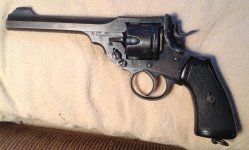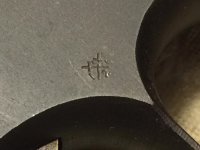.....since this pistol has so a long history of government service (basically 2 World Wars).
Is it common for the W&S pistols to remain in service this long or have this many stampings?
Once you look at the historical sequence, it does make sense, but the stampings do indeed accumulate.
When the .455 caliber was retired and the new .38 Enfield (for the military) and .38 Webley (adopted by most police in the Empire) was introduced around 1930, the old Webleys like yours ended up in a military storage depot somewhere, although some were apparently sold out of service already back then.
At the beginning of WW II, when the British government saw the size of its armed forces (and those of the Commonwealth) balloon, many of the .455 revolvers were reactivated, not for front-line military service, but they were given to home guards and to police in exchange for drafting their .38 Webleys. Remember the shortage of .38 revolvers that led to over half a million Smith & Wesson BSR’s shipped overseas.
Finally, in the second half of the 1950s, Britain began transitioning to the Browning HP as its military sidearm, although the official service revolver, the Enfield No.2 Mk I**, remained on duty into the 1960s.
That’s when Webleys (and S&W BSR’s) were finally “cleared out” and surplussed in significant numbers, requiring, however, commercial proofing before civilian sale as the military proofing during the war wasn’t deemed sufficient.
As was mentioned above, this does not even address the issue of a possible arsenal refinish and accompanying stamps (FTR) and any unit markings.
And if your gun had been imported into the US after a certain date, it would have been graced with the final indignity of an importer stamp

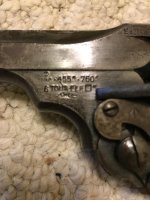 41937C14-67D3-4C69-81B4-8FFAE9E8984B.jpg56.7 KB · Views: 75
41937C14-67D3-4C69-81B4-8FFAE9E8984B.jpg56.7 KB · Views: 75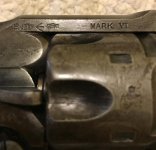 1D56161C-6715-40A4-91C1-EA08C7BB5060.jpg49.1 KB · Views: 71
1D56161C-6715-40A4-91C1-EA08C7BB5060.jpg49.1 KB · Views: 71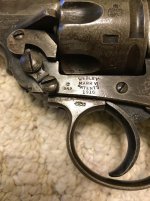 9AFA3F5D-DB0B-478E-91DE-802E13E86403.jpg69.7 KB · Views: 69
9AFA3F5D-DB0B-478E-91DE-802E13E86403.jpg69.7 KB · Views: 69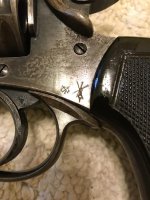 DA1B8F29-2531-4CA0-8BBC-8E27DA2CDD37.jpg65.5 KB · Views: 69
DA1B8F29-2531-4CA0-8BBC-8E27DA2CDD37.jpg65.5 KB · Views: 69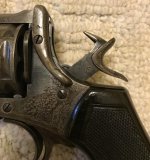 EC603660-BD46-45B7-9DFD-39F8C3E16876.jpg79.8 KB · Views: 62
EC603660-BD46-45B7-9DFD-39F8C3E16876.jpg79.8 KB · Views: 62


